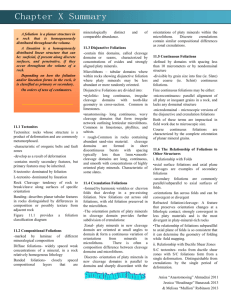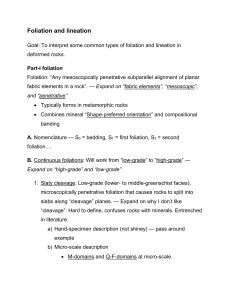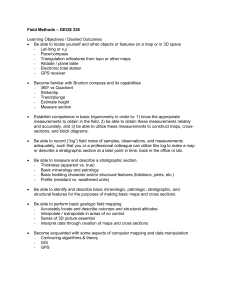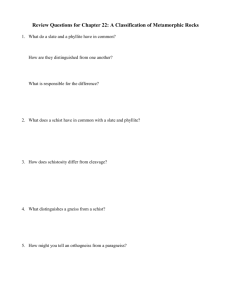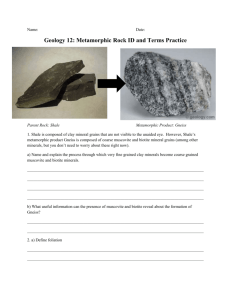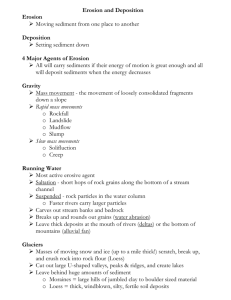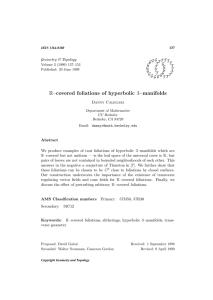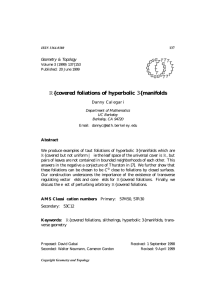Chapter 11 Summary
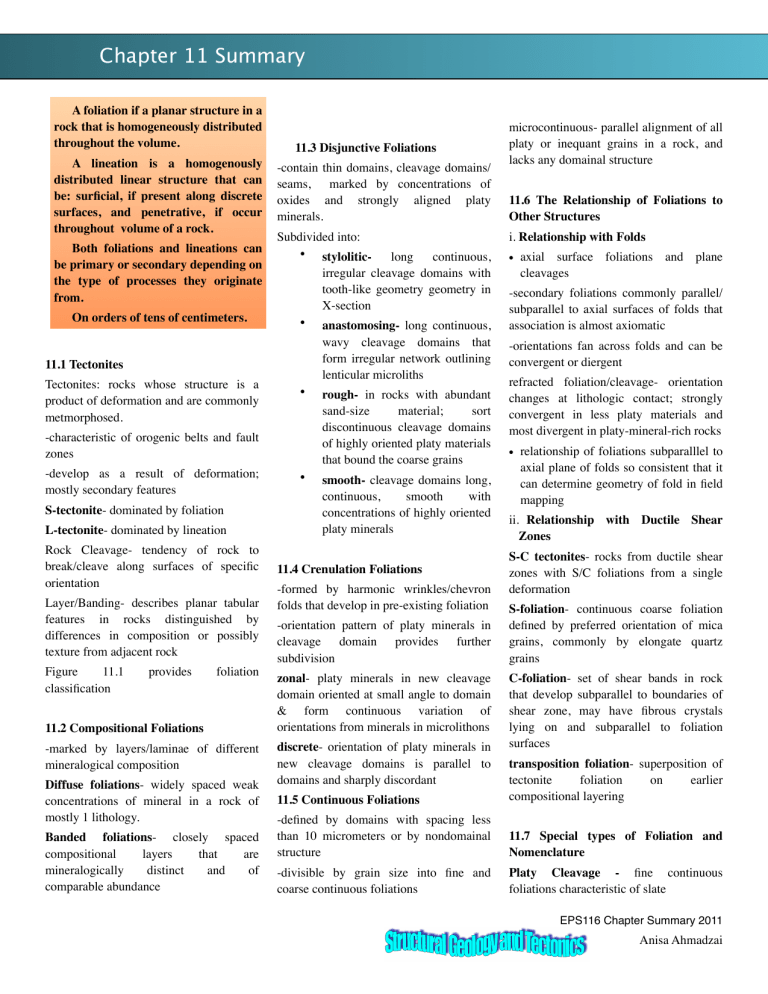
Chapter 11 Summary
A foliation if a planar structure in a rock that is homogeneously distributed throughout the volume.
A lineation is a homogenously distributed linear structure that can be: surficial, if present along discrete surfaces, and penetrative, if occur throughout volume of a rock.
Both foliations and lineations can be primary or secondary depending on the type of processes they originate from.
On orders of tens of centimeters.
11.1 Tectonites
Tectonites: rocks whose structure is a product of deformation and are commonly metmorphosed.
-characteristic of orogenic belts and fault zones
-develop as a result of deformation; mostly secondary features
S-tectonite - dominated by foliation
L-tectonite - dominated by lineation
Rock Cleavage- tendency of rock to break/cleave along surfaces of specific orientation
Layer/Banding- describes planar tabular features in rocks distinguished by differences in composition or possibly texture from adjacent rock
Figure 11.1 provides foliation classification
11.2 Compositional Foliations
-marked by layers/laminae of different mineralogical composition
Diffuse foliations - widely spaced weak concentrations of mineral in a rock of mostly 1 lithology.
Banded foliations - closely spaced compositional layers that are mineralogically distinct and of comparable abundance
11.3 Disjunctive Foliations
-contain thin domains, cleavage domains/ seams, marked by concentrations of oxides and strongly aligned platy minerals.
Subdivided into:
• stylolitic- long continuous, irregular cleavage domains with tooth-like geometry geometry in
X-section
• anastomosing- long continuous, wavy cleavage domains that form irregular network outlining lenticular microliths
• rough- in rocks with abundant sand-size material; sort discontinuous cleavage domains of highly oriented platy materials that bound the coarse grains
• smooth- cleavage domains long, continuous, smooth with concentrations of highly oriented platy minerals
11.4 Crenulation Foliations
-formed by harmonic wrinkles/chevron folds that develop in pre-existing foliation
-orientation pattern of platy minerals in cleavage domain provides further subdivision zonal - platy minerals in new cleavage domain oriented at small angle to domain
& form continuous variation of orientations from minerals in microlithons discrete - orientation of platy minerals in new cleavage domains is parallel to domains and sharply discordant
11.5 Continuous Foliations
-defined by domains with spacing less than 10 micrometers or by nondomainal structure
-divisible by grain size into fine and coarse continuous foliations microcontinuous- parallel alignment of all platy or inequant grains in a rock, and lacks any domainal structure
11.6 The Relationship of Foliations to
Other Structures i.
Relationship with Folds
• axial surface foliations and plane cleavages
-secondary foliations commonly parallel/ subparallel to axial surfaces of folds that association is almost axiomatic
-orientations fan across folds and can be convergent or diergent refracted foliation/cleavage- orientation changes at lithologic contact; strongly convergent in less platy materials and most divergent in platy-mineral-rich rocks
• relationship of foliations subparalllel to axial plane of folds so consistent that it can determine geometry of fold in field mapping ii.
Relationship with Ductile Shear
Zones
S-C tectonites - rocks from ductile shear zones with S/C foliations from a single deformation
S-foliation - continuous coarse foliation defined by preferred orientation of mica grains, commonly by elongate quartz grains
C-foliation - set of shear bands in rock that develop subparallel to boundaries of shear zone, may have fibrous crystals lying on and subparallel to foliation surfaces transposition foliation - superposition of tectonite foliation on earlier compositional layering
11.7 Special types of Foliation and
Nomenclature
Platy Cleavage - fine continuous foliations characteristic of slate
EPS116 Chapter Summary 2011
Anisa Ahmadzai
Phyllitic Cleavage - resembles slaty cleavage but grain size of rock slightly coarser
Schistosity - foliation found in coarsegrained, mica-rich, medium- to highgrade metamorphic rocks with chlorite, biotite, or muscovite defining the foliation
Gneissic Foliation- develop in gneisses in which platy minerals are sparse or absent
Flow Cleavage- applied to continuous axial surface foliations interpreted to be the result of large amount of ductile deformation in rocks.
Fracture Cleavage- variety of disjunctive foliations or discrete crenulation foliations
Shear, solution, and strain slip cleavages describe spaced foliations.
11.8 Structural Lineations
-defined by preferred orientation of linear structure contained within a rock discrete lineationsformed by deformation of discrete objects such as ooids, pebbles, fossils, and alteration spots constructed lineations- formed from planar features constructed or deformed during deformation and include intersection of 2 foliations, crenulation hinge lines, boudin lines, structural slickenlines, and mullions boudins- linear segments of a layer formed when the layer has been pulled apart along periodically spaced lines of separation called boudin lines pinch-and-swell structures are periodic oscillations in the thickness of a bed with pinches becoming thinner as the amount of lengthening of the bed increases mullions - linear fluted structures developed within a rock
Chevron/Kink Folds: cylindrical, al layers of sedimentary or metamorphic rock
11.9 Mineral Lineations
-consist of preferred orientation of either single elongate mineral grains or elongate polycrystalline aggregates
-grain lineations are formed by the parallel alignment of individual acicular mineral grains such as amphibole, by grains of minerals that have been stretched into an elongate shape, or by mineral fibers that have grown in a preferred orientation
Polycrystalline mineral lineations - formed by preferred orientation of elongate clusters of grains of a particular mineral measuring at least a few grains in diameter
(More descript details of specific types in section 11.9 pgs 314-316)
11.10 Associations of Lineations With
Other Structures i. Lineations and Foliations
-Some lineations are defined at least in part by foliations, and must be parallel
-Lineations may develop on surfaces other than foliations like fault surfaces ii. Lineations and Folds
-This relationship can decipher structural geometry of an area and in interpreting conditions under which the structures formed
-Because lineations are usually smaller structures than folds it may be easier to map geometry of fold hinges through these structures
-Lineations may be found parallel or perpendicular to fold aces and also as arbitrary angles to fold axes
References & Resources
Robert J. Twiss, Eldridge M. Moores,
Structural Geology 2nd edition, (W. H.
Freeman), p. 297-317, 2006
EPS116 Chapter Summary 2011
Anisa Ahmadzai
